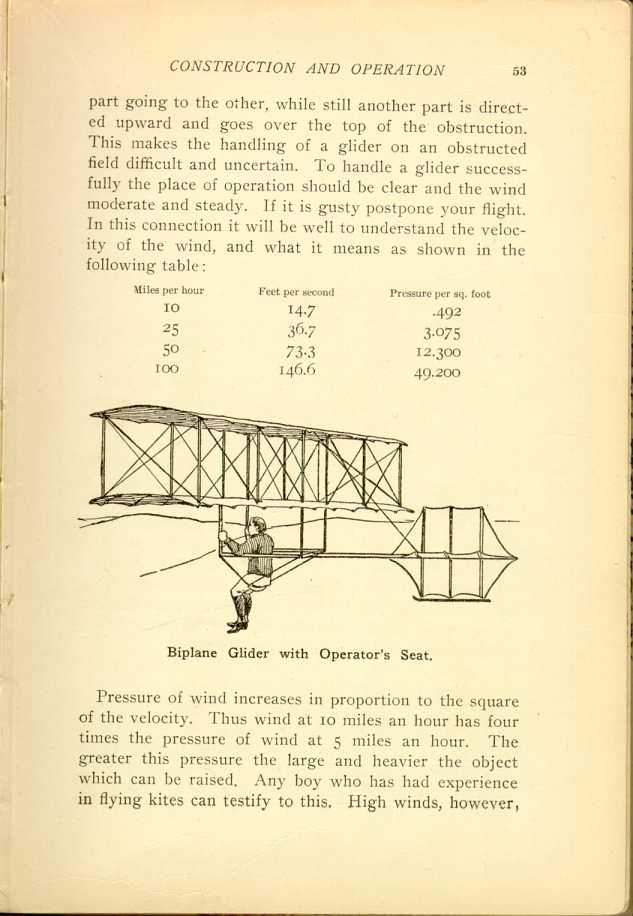| CHAPTER VI.
LEARNING TO FLY. Flying Machines: Construction and Operation: A Practical Book Which Shows, in Illustrations, Working Plans and Text, How to Build and Navigate the Modern Airship. | ||
6. CHAPTER VI.
LEARNING TO FLY.
Don't be too ambitious at the start. Go slow, and avoid unnecessary
risks. At its best there is an element of danger in aviation which
cannot be entirely eliminated,
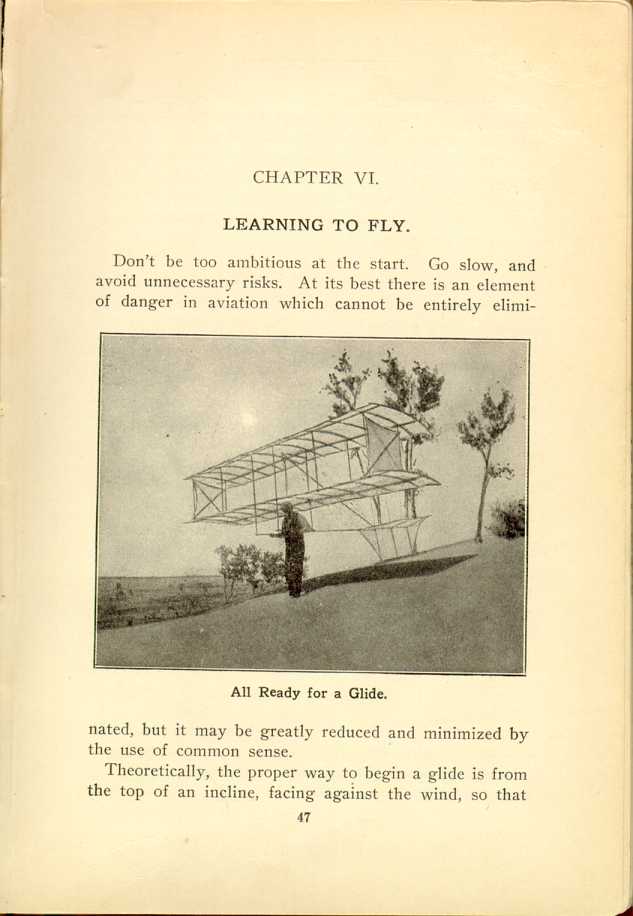
All Ready for a Glide.
[Description: Black and white photograph: Man in glider standing on hill.]
Theoretically, the proper way to begin a glide is from the top of an incline, facing against the wind, so that
Begin on Level Ground.
Make your first flights on level ground, having a couple of men to assist you in getting the apparatus under headway. Take your position in the center rectangle, back far enough to give the forward edges of the glider an inclination to tilt upward very slightly. Now start and run forward at a moderately rapid gait, one man at each end of the glider assisting you. As the glider cuts into the air the wind will catch under the uplifted edges of the curved planes, and buoy it up so that it will rise in the air and take you with it. This rise will not be great, just enough to keep you well clear of the ground. Now project your legs a little to the front so as to shift the center of gravity a trifle and bring the edges of the glider on an exact level with the atmosphere. This, with the momentum acquired in the start, will keep the machine moving forward for some distance.
Effect of Body Movements.
When the weight of the body is slightly back of the center of gravity the edges of the advancing planes are tilted slightly upward. The glider in this position acts as a scoop, taking in the air which, in turn, lifts it off the ground. When a certain altitude is reached—this varies with the force of the wind—the tendency to a forward movement is lost and the glider comes to the ground.
If you shift your body well forward it will bring the front edges
of the glider down, and elevate the rear ones.
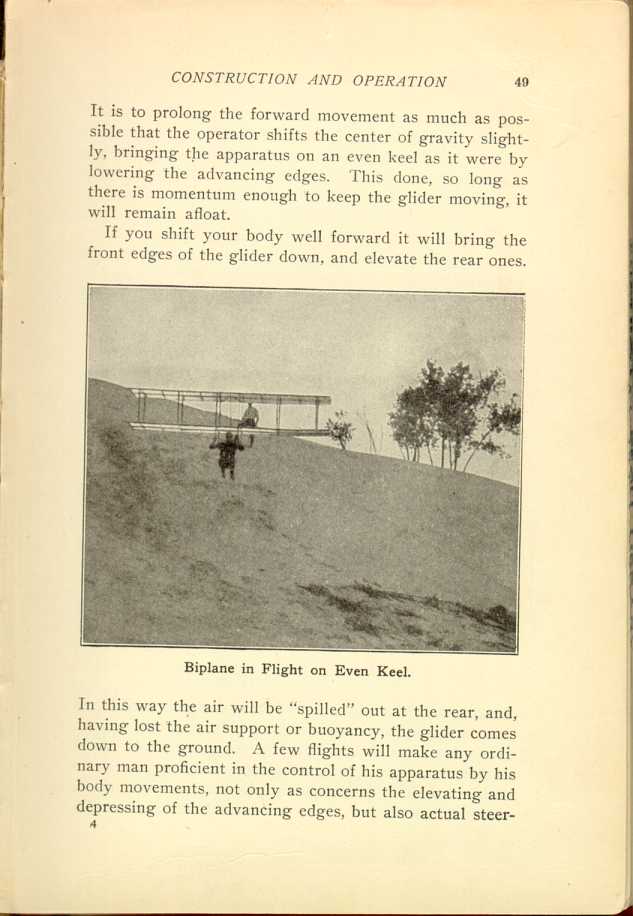
Biplane in Flight on Even Keel.
[Description: Black and white photograph: Man in biplane glider in flight,
with hill in background.]
Ascends at an Angle.
In ascending, the glider and flying machine, like the bird, makes an angular, not a vertical flight. Just what this angle of ascension may be is difficult to determine. It is probable and in fact altogether likely, that it varies with the force of the wind, weight of the rising body, power of propulsion, etc. This, in the language of physicists, is the angle of inclination, and, as a general thing, under normal conditions (still air) should be put down as about one in ten, or 5 3/4 degrees. This would be an ideal condition, but it has not, as vet been reached. The force of the wind affects the angle considerably, as does also the weight and velocity of the apparatus. In general practice the angle varies from 23 to 45 degrees. At more than 45 degrees the supporting effort is overcome by the resistance to forward motion.
Increasing the speed or propulsive force, tends to lessen the angle at which the machine may be successfully operated because it reduces the wind pressure. Most of the modern flying machines are operated at an angle of 23 degrees, or less.
Maintaining an Equilibrium.
Stable equilibrium is one of the main essentials to successful flight, and this cannot be preserved in an uncertain, gusty wind, especially by an amateur. The novice should not attempt a glide unless the conditions are just right. These conditions are: A clear, level space, without obstructions, such as trees, etc., and a
When a reasonable amount of proficiency in the handling of the
machine on level ground has been acquired the field of practice may be
changed to some gentle slope. In starting from a slope it will be found
easier
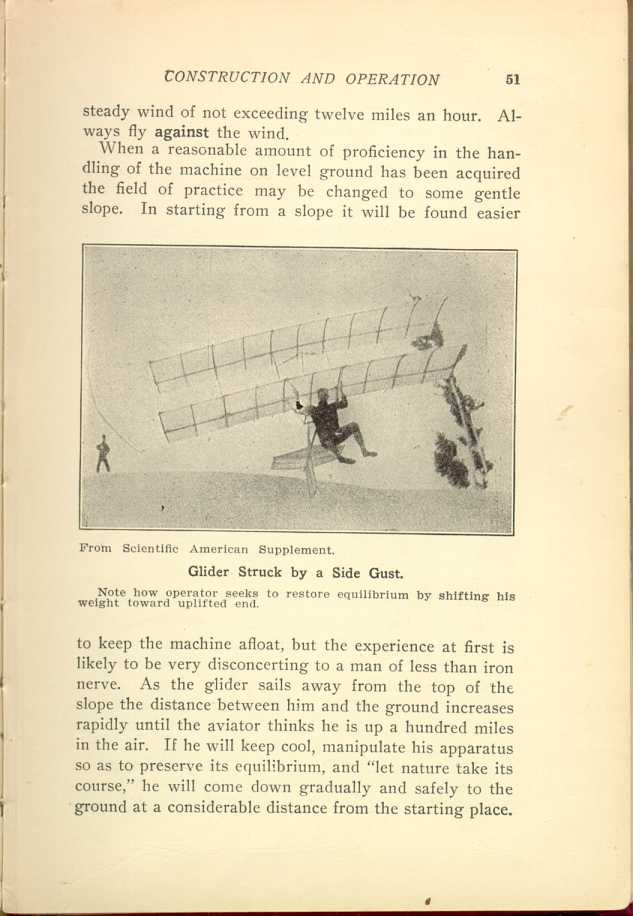
From Scientific American Supplement.
[Description: Black and white photograph: Man in glider, off-keel. Tree
blows to the left in background.]
Glider Struck by a Side Gust.
Note how operator seeks to restore equilibrium by shifting his weight
toward uplifted end.
But, if the aviator becomes "rattled"; if he loses control of his
machine, serious results, including a bad fall with risk of death, are
almost certain. And yet this practice is just as necessary as the
initial lessons on level ground. When judgment is used, and "haste made
slowly," there is very little real danger. While experimenting
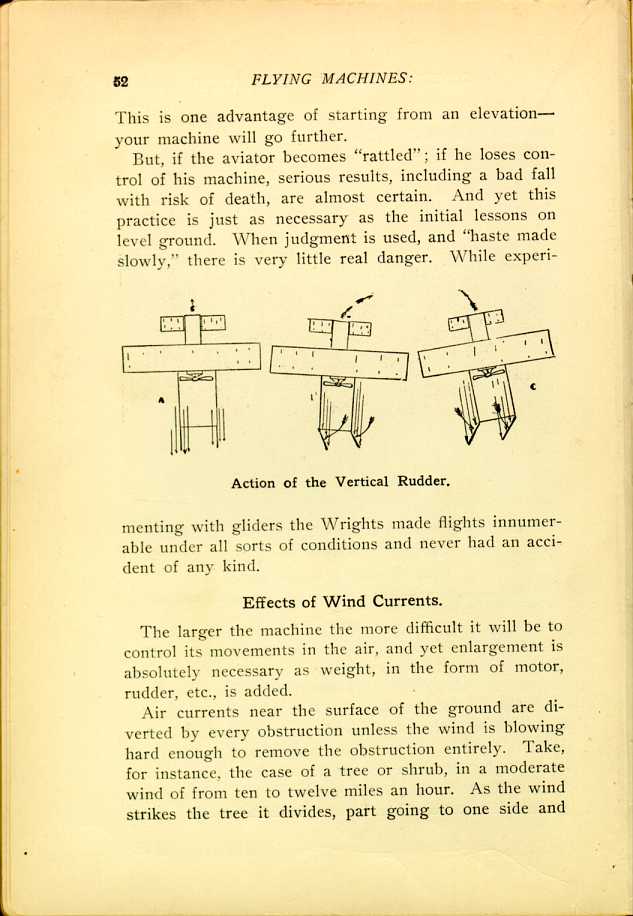
Action of the Vertical Rudder.
[Description: Black and white illustration: Three-part diagram of aeroplane
illustrating action of rudder.]
Effects of Wind Currents.
The larger the machine the more difficult it will be to control its movements in the air, and yet enlargement is absolutely necessary as weight, in the form of motor, rudder, etc., is added.
Air currents near the surface of the ground are diverted by every obstruction unless the wind is blowing hard enough to remove the obstruction entirely. Take, for instance, the case of a tree or shrub, in a moderate wind of from ten to twelve miles an hour. As the wind strikes the tree it divides, part going to one side and
| Miles per hour | Feet per second | Pressure per sq. foot |
| 10 | 14.7 | .492 |
| 25 | 36.7 | 3.075 |
| 50 | 73.3 | 12.300 |
| 100 | 146.6 | 49.200 |
Pressure of wind increases in proportion to the square of the velocity. Thus wind at 10 miles an hour has four times the pressure of wind at 5 miles an hour. The greater this pressure the large and heavier the object which can be raised. Any boy who has had experience in flying kites can testify to this, High winds, however,
Launching Device for Gliders.
On page 195 will be found a diagram of the various parts of a launcher for gliders, designed and patented by Mr. Octave Chanute. In describing this invention in Aeronautics, Mr. Chanute says:
"In practicing, the track, preferably portable, is generally laid in the direction of the existing wind and the car, preferably a light platform-car, is placed on the track. The truck carrying the winding-drum and its motor is placed to windward a suitable distance—say from two hundred to one thousand feet—and is firmly blocked or anchored in line with the portable track, which is preferably 80 or 100 feet in length. The flying or gliding machine to be launched with its operator is placed on the platform-car at the leeward end of the portable track. The line, which is preferably a flexible combination wire-and-cord cable, is stretched between the winding-drum on the track and detachably secured to the flying or gliding machine, preferably by means of a trip-hoop, or else held in the hand of the operator, so that the operator may readily detach the same from the flying-machine when the desired height is attained.
How Glider Is Started.
"Then upon a signal given by the operator the engineer at the motor puts it into operation, gradually increasing the speed until the line is wound upon the drum at a maximum speed of, say, thirty miles an hour. The operator of the flying-machine, whether he stands upright
"When the operator judges that his speed is sufficient, and this depends upon the velocity of the wind as well as that of the car moving against the wind, he quickly causes the front of the flying-machine to tip upward, so that the relative wind striking on the under side of the planes or carrying surfaces shall lift the flying machine into the air. It then ascends like a kite to such height as may be desired by the operator, who then trips the hook and releases the line from the machine.
What the Operator Does.
"The operator being now free in the air has a certain initial velocity imparted by the winding-drum and line and also a potential energy corresponding to his height above the ground. If the flying or gliding machine is provided with a motor, he can utilize that in his further flight, and if it is a simple gliding machine without motor he can make a descending flight through the air to such distance as corresponds to the velocity acquired and the height gained, steering meanwhile by the devices provided for that purpose.
"The simplest operation or maneuver is to continue the flight straight ahead against the wind; but it is possible to vary this course to the right or left, or even to return in downward flight with the wind to the vicinity of the starting-point. Upon nearing the ground the operator tips upward his carrying-surfaces and stops his headway upon the cushion of increased air resistance so caused. The operator is in no way permanently
Motor For the Launcher.
"The motor may be of any suitable kind or construction, but is preferably an electric or gasolene motor. The winding-drum is furnished with any suitable or customary reversing-guide to cause the line to wind smoothly and evenly upon the drum. The line is preferably a cable composed of flexible wire and having a cotton or other cord core to increase its flexibility. The line extends from the drum to the flying or gliding machine. Its free end may, if desired, be grasped and held by the operator until the flying-machine ascends to the desired height, when by simply letting go of the line the operator may continue his flight free. The line, however, is preferably connected to the flying or gliding machine directly by a trip-hook having a handle or trip lever within reach of the operator, so that when he ascends to the required height he may readily detach the line from the flying or gliding machine."
| CHAPTER VI.
LEARNING TO FLY. Flying Machines: Construction and Operation: A Practical Book Which Shows, in Illustrations, Working Plans and Text, How to Build and Navigate the Modern Airship. | ||
